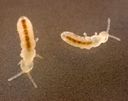Folsomia
Folsomia
Classification
- Phylum: Arthropoda
- Subphylum: Hexapoda
- Class: Collembola
- Order: Entomobryomorpha
- Family: Isotomidae
- Subfamily: Proisotominae
- Genus: Folsomia
Pronunciation
How to pronounce Folsomia: /fɔlˈsoʊmiə/
These audio files are automatically generated. While they are not always 100% accurate, they are a good starting point.
Images






Summary
Folsomia candida is a globally distributed species of springtail known for its parthenogenetic reproduction and use as a model organism in ecological research, particularly related to soil health and invertebrate interactions.
Physical Characteristics
Folsomia candida has an unpigmented, slender body up to 3 mm (0.1 in) in length. The head has a pair of four-segmented antennae and post-antennal organs, but no eyespots. The first thoracic segment's dorsal part is reduced, and the posterior three abdominal segments are fused. The ventral side of the fourth abdominal segment bears a furca used for jumping, which is characterized by the number of bristles on this organ.
Identification Tips
The number of bristles on the furca distinguishes Folsomia candida from other species in the genus Folsomia.
Habitat
Found in high organic content soils, leaf litter in forests, on stream verges, as well as in mines and caves.
Distribution
Global distribution, often referred to as a 'tramp' species, due to its spread in soil and plant pots.
Diet
Primarily feeds on the hyphae of fungi, including root mycorrhizae.
Life Cycle
Females reproduce parthenogenically, with globular white eggs hatching in about one week at 21 °C (70 °F). The life cycle involves five molts before maturity, with adults continuing to molt approximately 45 times during their lives.
Reproduction
Folsomia candida is parthenogenic, consisting only of female populations with each capable of laying about a thousand eggs.
Ecosystem Role
May be beneficial to crops by feeding on plant-pathogenic nematodes and mites.
Economic Impact
Used in laboratory studies to assess the effects of pesticides and soil pollutants on non-target soil invertebrates.
Cultural Significance
In use for over forty years as a model organism in various ecological and biological research topics.
Collecting Methods
- Hand collection from soil and leaf litter
- Using pitfall traps
Preservation Methods
- Preserved in ethanol for laboratory studies
- Kept in cultures with granulated baker's yeast as food
Misconceptions
Some may confuse springtails with harmful pests, but they play different roles in the ecosystem, often having beneficial effects.
Tags
- springtail
- Folsomia
- isotomidae
- soil ecology
- model organism